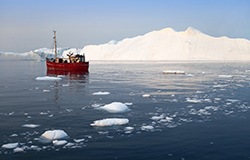Giving the Arctic Ocean a top to bottom health check
Climate-driven oceanic transformations are especially pronounced in the Arctic Ocean, with phenomena such as sea ice cover, hydrography and circulation strongly influencing biological productivity and ecosystem make-up. However, a comprehensive understanding of this climactic impact has been lacking, due to limited information about the precise underlying chemical, physical and biological interactions involved. The distribution and isotopic composition of many oceanic trace elements and gases provides information about these biogeochemical and physical processes. These in turn directly affect biological productivity, carbon cycling and the emission of climatically important trace gases, with some providing essential micronutrients (e.g. zinc) and others acting as toxicants (e.g. mercury). Given the anticipated increase of resource exploitation in the Arctic, along with wider climate change concerns, a better understanding of the distribution and cycling of trace element and isotopes (TEI) and dissolved gases in the Arctic Ocean, is of timely concern for an assessment of the ocean’s resilience and future. The GEOTRACES-ARCTIC initiative forms part of the wider GEOTRACES program which was set up precisely to provide this by conducting multi-country coordinated research. Sifting sediment, ocean surface and aerosol samples ARCTIC GEOTRACES is part of a wider program to cover the global ocean, conducted through a series of cruises in different sections of the ocean to map trace element and isotope distribution in a quest to better understand the underlying processes. The multiple country coordinated program is due to end in 2018 and has three main objectives. Firstly; to establish an Arctic Ocean geochemical baseline, secondly; to understand current biogeochemical distributions and lastly; to predict change to the Arctic’s geochemistry. The sheer scale of the study means a wealth of data for many years of analysis. Yet, already results are being made available, with some recently presented at the Association for the Sciences of Limnology and Oceanography conference in Hawaii. The research, amongst other factors, looked at the CO2-carbonate chemistry of the Arctic Ocean and sea ice. This matters because climate change induced ocean surface warming, combined with increased sea ice melt, have freshened the upper ocean and exposed the surface to the atmosphere. This then has a direct impact on air-ice-ocean carbon dioxide (CO2) exchange, oceanic carbonate chemistry and ocean acidification. The team found further support for the notion that human activity is responsible for increasing carbon concentration in Atlantic waters. In intermediate (100-1500m depth) waters, they found significant increases in anthropogenic CO2 in the Nansen Basin (0.74 ± 0.10 mol C m-2 yr-1) and Amundsen Basin (0.95 ± 0.25 mol C m-2 yr-1). This has led to a reduction in Ph of 0.02-0.05 units over the last two decades, resulting in rapid acidification at these depths by lowering calcium carbonate saturation states. One of the largest ever Arctic research programs GEOTRACES has now successfully completed 1024 sampling stations and 94 cruises. As well as using Section cruises to gather data, the GEOTRACES program also endorses additional research that looks at particular regions or processes. The programme then collates the inter-calibrated trace element and isotope data from other cruises. These efforts all have to be compliant with the relevant programme criteria and guidelines, and to meet with approved by the International GEOTRACES Steering Committee. The information about GEOTRACES cruises is maintained by the GEOTRACES International Data Management Centre (GDAC) at the British Oceanographic Data Centre (Liverpool, United Kingdom). For more information, please visit: Programme website(opens in new window) CORDIS project page(opens in new window)
Countries
France



